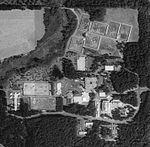Aloha Farmhouse
1915 establishments in OregonHouses completed in 1915Houses in Washington County, OregonHouses on the National Register of Historic Places in OregonNational Register of Historic Places in Washington County, Oregon ... and 1 more
Wikipedia page with obscure subdivision

The Aloha Farmhouse is a Craftsman-inspired residence located in Aloha, Oregon, United States, listed on the National Register of Historic Places. The one-story house was built in 1915, and architect Pietro Belluschi remodeled the building twice, first in 1944 and again in 1946. The Belluschis moved from the home in 1948 and sold the property. It was added to the National Register of Historic Places in September 2015.
Excerpt from the Wikipedia article Aloha Farmhouse (License: CC BY-SA 3.0, Authors, Images).Aloha Farmhouse
Southwest 197th Avenue,
Geographical coordinates (GPS) Address External links Nearby Places Show on map
Geographical coordinates (GPS)
| Latitude | Longitude |
|---|---|
| N 45.512 ° | E -122.879 ° |
Address
Aloha Farmhouse
Southwest 197th Avenue 1080
97003
Oregon, United States
Open on Google Maps







